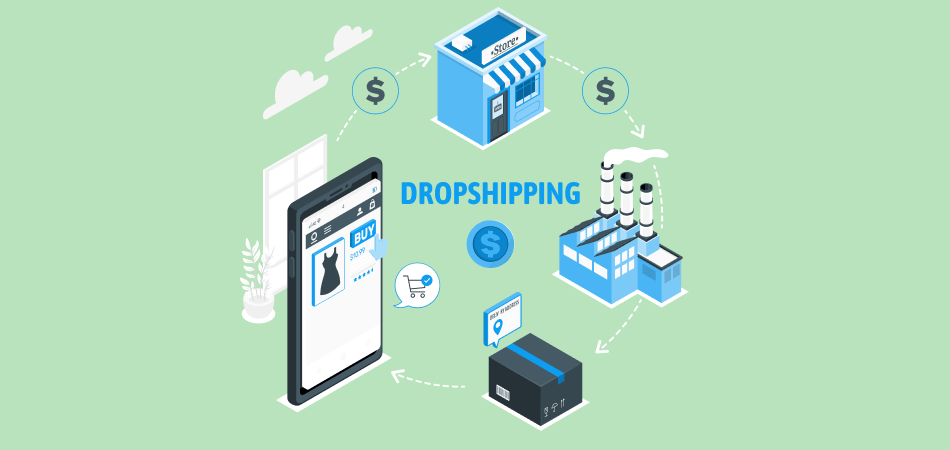The internet is flooded with stories of 22-year-olds making millions through dropshipping, flaunting Lamborghinis and beachfront mansions. But for every success story plastered across YouTube, there are hundreds of failed ventures that maxed out credit cards and shattered dreams. Dropshipping has become the most misunderstood business model of our time—simultaneously hailed as the path to financial freedom and condemned as a get-rich-quick scam. The truth, as always, lies somewhere in between. Today, we’re pulling back the curtain on dropshipping to reveal what it really is, why it creates such extreme outcomes, and most importantly, how to approach it with eyes wide open. Whether you’re considering dropshipping or simply curious about this e-commerce phenomenon, this guide will separate fact from fiction.
What Dropshipping Really Is (Hint: It’s Not Magic)
Dropshipping is a retail fulfillment method where online stores don’t keep products in stock. Instead, when a customer places an order, the store purchases the item from a third party—usually a wholesaler or manufacturer—who ships it directly to the customer. The store owner never sees or handles the product. It’s essentially being a middleman in the digital age, connecting buyers with suppliers while handling the marketing and customer acquisition.
The appeal is obvious: no inventory investment, no warehouse needed, no shipping logistics to manage. You can start a “store” with just a laptop and internet connection. This low barrier to entry has democratized e-commerce, allowing anyone to become an online retailer. A Toronto college student can compete with established brands, at least in theory. This accessibility explains why dropshipping has exploded, with thousands launching stores daily.
But here’s what the gurus don’t emphasize: dropshipping isn’t a business model—it’s a fulfillment method. The real business is in marketing, customer service, and brand building. Successful dropshippers aren’t just listing products; they’re creating value through curation, marketing expertise, and customer experience. Understanding this distinction separates the millionaires from the bankruptcies. When combined with professional web design and development, dropshipping becomes a legitimate business rather than a quick scheme.
The Millionaire-Making Machine: Why Some Succeed Spectacularly
The dropshipping success stories aren’t myths—they’re real, documented, and increasingly common. Some entrepreneurs have built eight-figure businesses from their dorm rooms. What separates these winners from the masses? They understand that dropshipping success requires the same fundamentals as any business: identifying market needs, delivering value, and executing brilliantly.
Successful dropshippers excel at finding product-market fit before anyone else. They spot trending products through data analysis, social media monitoring, and consumer behavior patterns. A Montreal entrepreneur made $2 million selling posture correctors by identifying the work-from-home trend early. Another built a empire around eco-friendly products before sustainability went mainstream. These winners don’t just follow trends—they anticipate them.
The technical execution matters enormously. Million-dollar dropshipping stores invest heavily in user experience, site speed, and conversion optimization. They test hundreds of product descriptions, images, and pricing strategies. They build email lists and create content that attracts organic traffic. Most importantly, they reinvest profits into growth rather than lifestyle. The dropshippers driving Lamborghinis usually bought them after years of reinvestment, not months. This long-term thinking, supported by strategic content marketing, builds sustainable businesses rather than flash-in-the-pan successes.
The Bankruptcy Blueprint: How Dreams Become Nightmares
For every dropshipping millionaire, there are countless financial casualties. The failure rate in dropshipping exceeds 90%, higher than traditional businesses. Understanding why people fail is crucial for anyone considering this path. The most common thread among failures? Believing dropshipping is easy money rather than hard work.
The first trap is the “build it and they will come” mentality. Launching a Shopify store and listing products doesn’t generate sales. Without marketing expertise and budget, stores remain invisible in the vast internet ocean. Beginners often burn through savings on Facebook ads without understanding targeting, creative development, or conversion optimization. A Toronto couple lost $30,000 trying to sell fitness equipment through poorly targeted ads that generated traffic but no sales.
The second major failure point is supplier relationships. Choosing unreliable suppliers leads to delayed shipments, quality issues, and angry customers. When products arrive damaged or different from descriptions, the store owner faces the backlash while the supplier remains insulated. Many beginners discover too late that their “trusted supplier” is actually a middleman adding another layer of complexity and cost. These operational nightmares destroy reputation faster than any marketing can build it.
The Hidden Costs Nobody Talks About
Dropshipping’s “no inventory” promise blinds people to substantial hidden costs. While you don’t buy inventory upfront, successful dropshipping requires significant investment in other areas. Marketing costs typically consume 20-30% of revenue. Professional product photography, which can make or break conversions, costs hundreds per product. Website development, apps, and tools add up quickly.
Customer acquisition costs in competitive niches shock newcomers. Popular products might require $50-100 in advertising spend to generate one sale, with profit margins of $10-20. This means you need substantial capital to test products, optimize campaigns, and scale winners. The days of $100 startup budgets creating profitable stores are largely mythology. Realistic budgets start at $3,000-5,000 for proper testing and optimization.
Time investment represents another hidden cost. Successful dropshipping isn’t passive income—it’s active business management. Product research takes hours daily. Customer service never stops. Supplier management requires constant attention. Marketing campaigns need continuous optimization. Many aspiring dropshippers, expecting four-hour workweeks, discover they’re working harder than their day jobs. This time commitment, when properly directed toward SEO and organic growth, can build lasting value rather than temporary profits.
The Legal Landscape: Compliance Isn’t Optional
The casual approach many take to dropshipping ignores serious legal obligations. Operating an online store means complying with consumer protection laws, tax requirements, and international trade regulations. Ignorance isn’t a defense when authorities come knocking, and they increasingly do as dropshipping grows.
Sales tax compliance has become particularly complex. Many dropshippers don’t realize they may owe sales tax in multiple jurisdictions based on economic nexus laws. Selling to customers across Canada and internationally creates tax obligations that can result in massive unexpected bills. A British Columbia dropshipper faced $150,000 in back taxes after two successful years, wiping out all profits because they didn’t understand tax obligations.
Product liability represents another legal minefield. When you sell a product, you’re legally responsible for its safety and performance, even if you never touch it. Selling electronics without proper certifications, cosmetics without ingredient compliance, or toys without safety testing can result in lawsuits that destroy businesses and personal finances. Smart dropshippers work with legal counsel to understand obligations and protect assets through proper business structures.
The Technology Stack: Building for Scale
Modern dropshipping success requires sophisticated technology infrastructure. Gone are the days of basic Shopify stores with AliExpress plugins. Winning dropshippers build tech stacks that automate operations, optimize performance, and scale efficiently. Understanding these technical requirements separates hobbyists from serious entrepreneurs.
The foundation starts with a professionally designed, high-converting website. Template stores signal amateur status to increasingly sophisticated consumers. Custom design that reflects brand values and optimizes user experience becomes essential. Speed optimization, mobile responsiveness, and conversion rate optimization tools form the technical baseline. Successful stores invest in heat mapping, A/B testing platforms, and analytics tools that provide actionable insights.
Automation tools transform dropshipping from overwhelming to manageable. Order management systems sync inventory across suppliers. Customer service platforms handle common inquiries automatically. Email marketing automation nurtures leads and encourages repeat purchases. Social media schedulers maintain consistent presence. This technology stack, properly implemented with social media marketing integration, enables one person to manage what previously required a team.
Finding Your Niche: The Make-or-Break Decision
Product selection determines dropshipping success more than any other factor. The temptation to sell everything to everyone guarantees failure. Successful dropshippers understand that riches exist in niches—specific product categories serving defined audiences with particular needs. This focused approach enables effective marketing and brand building.
Winning niches share common characteristics: passionate audiences, problem-solving products, and reasonable competition. Pet owners spending billions on their furry friends create opportunities. Work-from-home professionals needing ergonomic solutions represent growing demand. Eco-conscious consumers seeking sustainable alternatives drive emerging markets. The key lies in matching personal knowledge or interests with market opportunity.
Research tools have democratized niche discovery. Google Trends reveals rising interests. Social media listening identifies unmet needs. Competitor analysis shows market gaps. But tools only provide data—successful niche selection requires understanding human psychology and market dynamics. A Vancouver dropshipper built a million-dollar business selling specialized camping gear by combining personal outdoor expertise with identified market demand for ultralight equipment.
The Marketing Reality: Where Success Lives or Dies
Marketing separates dropshipping winners from losers more definitively than any other skill. The best products with perfect pricing fail without effective marketing. Conversely, average products marketed brilliantly generate fortunes. Understanding modern digital marketing becomes non-negotiable for dropshipping success.
Paid advertising, particularly Facebook and Google Ads, drives most dropshipping sales initially. But successful advertising requires more than boosting posts or running basic campaigns. It demands understanding audience psychology, creating compelling creative, writing persuasive copy, and optimizing ruthlessly based on data. The learning curve is steep and expensive. Many beginners quit after burning through budgets without sales, not realizing they’re just beginning to learn.
Organic marketing provides sustainable growth beyond paid acquisition. Content marketing, SEO, influencer partnerships, and social media presence build assets that generate sales without ongoing ad spend. Email marketing to captured leads often provides the highest ROI. The most successful dropshippers balance paid acquisition for immediate revenue with organic strategies for long-term growth. This marketing mix creates businesses that survive algorithm changes and rising ad costs.
Building a Brand vs. Chasing Quick Profits
The fundamental choice facing every dropshipper is building a brand versus chasing trending products for quick profits. This decision influences every subsequent choice and largely determines whether you’ll create lasting wealth or temporary income. The market increasingly rewards brand builders while punishing trend chasers.
Brand building in dropshipping means creating unique value beyond product availability. It involves developing a distinct voice, visual identity, and customer experience. Successful brands curate products that align with specific values or lifestyles. They create content that educates and entertains. They build communities around shared interests. This approach takes longer but creates defensive moats against competition.
The quick profit approach—jumping between trending products without building lasting assets—becomes increasingly difficult. Ad costs rise faster than margins. Competition intensifies within days of identifying winners. Platform changes can eliminate profitability overnight. While some still profit from this approach, it requires constant hustle without building lasting value. The dropshippers creating real wealth focus on brand building from day one.
Your Dropshipping Decision Framework
After understanding dropshipping’s reality—both opportunities and challenges—how do you decide if it’s right for you? Success requires honest self-assessment about skills, resources, and expectations. Dropshipping isn’t for everyone, but for the right people, it offers genuine opportunity.
Essential skills include digital marketing proficiency, basic technical competence, financial management, and customer service excellence. You need risk tolerance for testing products and campaigns that might fail. Startup capital of at least $3,000-5,000 provides realistic testing budgets. Most importantly, you need patience for building a real business rather than expecting overnight success.
Consider alternatives that might better match your situation. Amazon FBA offers more structured approaches. Digital products eliminate fulfillment entirely. Service businesses leverage expertise without inventory. Traditional e-commerce with inventory provides better margins and control. Dropshipping is one option among many—choose based on alignment with your goals, skills, and resources.
The Truth About Dropshipping
Dropshipping isn’t a scam or a guaranteed path to riches—it’s a legitimate business model with specific advantages and challenges. Success requires the same fundamentals as any business: solving real problems, delivering value, and executing excellently. The low barriers to entry that make dropshipping accessible also create intense competition that rewards only the most committed and capable.
The millionaire dropshippers are real, but they’re not lucky—they’re skilled entrepreneurs who happened to choose dropshipping as their vehicle. They would likely succeed in other business models too. The bankruptcies are equally real, usually resulting from treating dropshipping as easy money rather than serious business. Understanding this reality helps set appropriate expectations and strategies.
For those willing to learn marketing, build brands, and commit to long-term growth, dropshipping offers genuine opportunity. The model’s flexibility and low initial investment enable testing and learning without catastrophic risk. But success requires treating it as a real business from day one, not a side hustle or get-rich-quick scheme.
Ready to build a dropshipping business the right way? ByteInspired specializes in creating high-converting dropshipping websites that set you up for long-term success. From professional design that builds trust to technical optimization that maximizes conversions, we provide the foundation serious dropshippers need. Don’t join the 90% who fail due to poor execution. Contact us today to discover how professional website development can transform your dropshipping dreams into profitable reality.
To visit our social media please click on Facebook and Instagram





